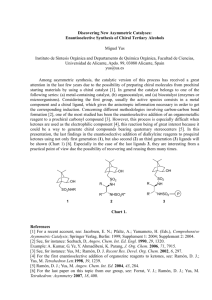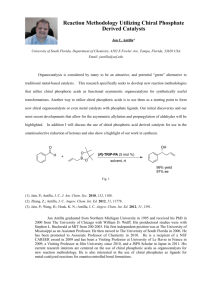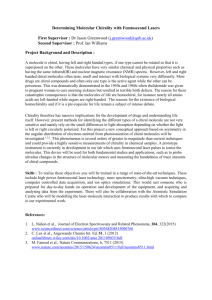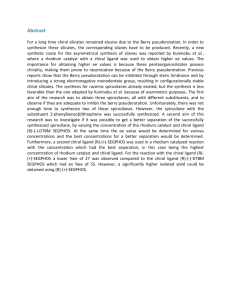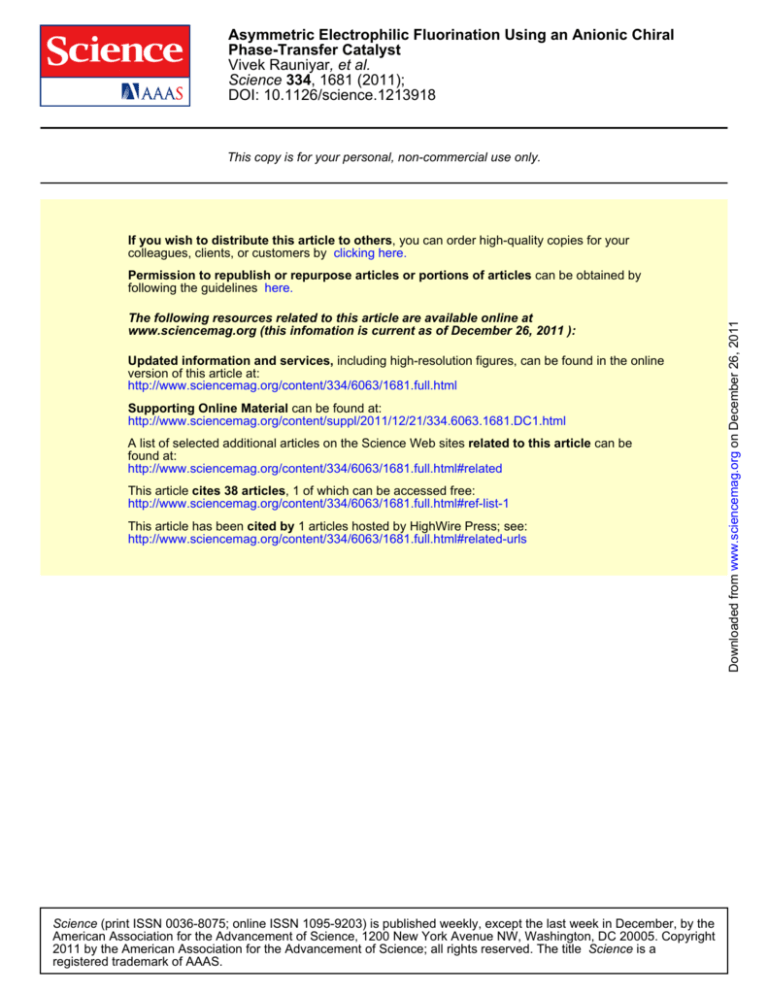
Asymmetric Electrophilic Fluorination Using an Anionic Chiral
Phase-Transfer Catalyst
Vivek Rauniyar, et al.
Science 334, 1681 (2011);
DOI: 10.1126/science.1213918
This copy is for your personal, non-commercial use only.
If you wish to distribute this article to others, you can order high-quality copies for your
colleagues, clients, or customers by clicking here.
The following resources related to this article are available online at
www.sciencemag.org (this infomation is current as of December 26, 2011 ):
Updated information and services, including high-resolution figures, can be found in the online
version of this article at:
http://www.sciencemag.org/content/334/6063/1681.full.html
Supporting Online Material can be found at:
http://www.sciencemag.org/content/suppl/2011/12/21/334.6063.1681.DC1.html
A list of selected additional articles on the Science Web sites related to this article can be
found at:
http://www.sciencemag.org/content/334/6063/1681.full.html#related
This article cites 38 articles, 1 of which can be accessed free:
http://www.sciencemag.org/content/334/6063/1681.full.html#ref-list-1
This article has been cited by 1 articles hosted by HighWire Press; see:
http://www.sciencemag.org/content/334/6063/1681.full.html#related-urls
Science (print ISSN 0036-8075; online ISSN 1095-9203) is published weekly, except the last week in December, by the
American Association for the Advancement of Science, 1200 New York Avenue NW, Washington, DC 20005. Copyright
2011 by the American Association for the Advancement of Science; all rights reserved. The title Science is a
registered trademark of AAAS.
Downloaded from www.sciencemag.org on December 26, 2011
Permission to republish or repurpose articles or portions of articles can be obtained by
following the guidelines here.
Asymmetric Electrophilic Fluorination
Using an Anionic Chiral
Phase-Transfer Catalyst
Vivek Rauniyar,* Aaron D. Lackner,* Gregory L. Hamilton, F. Dean Toste†
The discovery of distinct modes of asymmetric catalysis has the potential to rapidly advance chemists’
ability to build enantioenriched molecules. As an example, the use of chiral cation salts as phase-transfer
catalysts for anionic reagents has enabled a vast set of enantioselective transformations. Here, we present
evidence that a largely overlooked analogous mechanism wherein a chiral anionic catalyst brings a
cationic species into solution is itself a powerful method. The concept is applied to the enantioselective
fluorocyclization of olefins with a cationic fluorinating agent and a chiral phosphate catalyst. The
reactions proceed in high yield and stereoselectivity, especially considering the scarcity of alternative
approaches. This technology can in principle be applied to the large portion of reaction space that uses
positively charged reagents and reaction intermediates.
n the years since Knowles and co-workers
demonstrated that synthetic catalysts could
approach the levels of absolute stereocontrol
achieved by enzymes (1), chemists have made
remarkable progress on the synthesis of optically
active molecules using catalytic chiral inputs.
Despite the advances, the subset of reactions that
can be performed with enantioselective methods
still represents only a fraction of the pool of known
organic transformations. One reason for this discrepancy is that, although new ligand designs and
catalyst variants have been reported at a striking
rate, a slower pace has been set for devising
alternative underlying approaches to inducing
asymmetry.
Among the distinct strategies that complement the traditional metal-chiral ligand methods,
asymmetric phase-transfer catalysis has undoubtedly been one of the most successful. In this
mode of catalysis, a lipophilic chiral cation salt
mediates the reaction between a substrate in
organic solution and an anionic reagent in a
separate aqueous or solid phase. Ion pairing
with the cation solubilizes the anionic reagent
or reaction intermediate in the bulk organic
phase, while also providing a chiral environment for the desired reaction with the substrate.
Application of this simple logic has yielded a
diverse array of operationally simple, highly
enantioselective protocols (2–5).
However, almost no consideration has been
given to an analogous charge-inverted strategy
in which the salt of a chiral anion brings an insoluble cationic promoter into solution. Positively charged reagents and reaction intermediates
are certainly quite common, so in principle this
neglected other half of phase-transfer catalysis
I
Department of Chemistry, University of California, Berkeley, CA
94720, USA.
*These authors contributed equally to this work.
†To whom correspondence should be addressed. E-mail:
fdtoste@berkeley.edu
could be quite useful. Nelson and colleagues
appreciated this possibility when they titled a
2003 publication “Towards phase-transfer catalysts with a chiral anion” (6). Although this report
nicely demonstrated some asymmetric induction
by a chiral borate anion in a ring opening of
prochiral aziridinium intermediates, no catalysis
(phase-transfer or otherwise) was investigated.
The challenge of rendering this reaction catalytic
and highly enantioselective seemed to us to be an
excellent testing ground for the possibility of
chiral anion phase-transfer catalysis. We realized
this goal using a chiral phosphate anion catalyst
and Ag+ (in the form of silver carbonate) as the
insoluble stoichiometric promoter (7). Essential
to our success was the previous discovery that
binaphthol-derived phosphates could convey
asymmetry during reactions of cationic species
(8–10) independent of their ability to act as chiral
Brønsted acids and hydrogen-bond donors (11).
Although this previous report hinted at the
promise of the underlying concept, we hoped
to find an area of chemistry with broader utility
where charge-inverted phase-transfer catalysis
could be uniquely advantageous. In this context, procedures for the construction of carbonfluorine bonds are highly prized because of the
scarcity of methods and the value of the products
across applied chemistry (12–15). Electrophilic
reagents have proven to be one of the most applicable vehicles for introducing fluorine into
organic molecules (16–21). Unfortunately, the
mechanism of these reactions offers little room
for the addition of a chiral catalyst. Many of the
most effective published enantioselective fluorination protocols require formation of a nucleophilic chiral enolate equivalent (22–30), including
one report of formation through chiral cationic
phase-transfer catalysis (26). On the other hand,
the catalytic generation of a chiral electrophile
has proven quite challenging; usually a stoichiometric amount of chiral promoter is necessary
to suppress the racemic background reaction
(31–34). With the current limitations in mind, we
envisioned a chiral anion phase-transfer approach
to electrophilic fluorination through the use of an
insoluble cationic electrophilic fluorination reagent in conjunction with a chiral phosphate
catalyst.
Specifically, we targeted Selectfluor (1, Fig. 1)
as a versatile cationic fluorinating agent that would
normally be insoluble in nonpolar media. We hypothesized that lipophilic, bulky chiral phosphate
anions such as 2 (Fig. 1) could exchange with one
or both of the tetrafluoroborate anions associated
with Selectfluor to bring the reagent into solution.
The resulting chiral ion pair could then mediate
an asymmetric fluorination of an organic substrate
in solution. Given its insolubility, no appreciable
background reaction between Selectfluor and substrate would be anticipated.
To properly test our idea, it also seemed logical
to investigate a previously unexplored reaction
that would not be amenable to chiral nucleophile–
based methods. We noted that fluorocyclizations,
wherein a pendant nucleophile attacks a p-bond
activated by an electrophilic fluorine source, are
much less common than the analogous reactions
of heavier halogens (35), and enantioselective var-
Downloaded from www.sciencemag.org on December 26, 2011
REPORTS
Fig. 1. Catalytic formation of a chiral fluorination reagent via
chiral anion–mediated phase transfer in nonpolar solvents.
www.sciencemag.org
SCIENCE
VOL 334
23 DECEMBER 2011
1681
iants are almost unknown (34). Based on precedent showing that enol ethers react efficiently
with Selectfluor, we first focused on dihydropyran
substrates tethered to various nucleophilic traps.
Initial experimentation revealed that benzamide
nucleophiles perform particularly well under the
designed catalytic conditions (Fig. 2). These substrates display an interesting mode of reactivity
wherein, upon fluorination of the enol ether, the
amide carbonyl attacks the nascent oxocarbenium
ion to form a spiro-fused oxazoline.
After brief optimization of the reaction parameters, the product from the model substrate 3a
could be obtained in 86% yield with exceptional
enantio- and diastereoselectivity (92% ee, >20:1
diasteromer ratio) (Fig. 2). The inclusion of Proton Sponge [1,8-bis(dimethylamino)naphthalene]
as a base served a dual purpose of generating the
anionic phosphate catalyst in situ from its conjugate acid 2b as well as neutralizing the equivalent
of acid generated during the reaction. Consistent
with our design plan, the hydrophobic alkyl chains
attached to the backbone of the catalyst proved
beneficial: Use of the unsubstituted catalyst (2c)
reduced the enantioselectivity to 87%. Additionally, products with a variety of substituents on the
benzamide ring—including halides, nitro, and alkyl
groups—could be obtained in very good yields
with enantioselectivities above 95% (products 4b
to 4f). Substitutions at the 2- or 3-positions of the
aryl ring gave rise to slightly more variability in
terms of yield and stereoselectivity but were generally well tolerated (4g to 4i). The absolute stereochemistry of product 4c as shown in Fig. 2 was
determined by single-crystal x-ray diffraction
(see the supporting online material for crystallographic data), and all other products were assigned by analogy.
We were naturally eager to extend the methodology to less electron-rich alkenes. However,
this represented quite a challenge, as previously
reported catalytic asymmetric electrophilic fluorination methods have largely relied on enol,
enolate, or other strongly activated nucleophiles.
Thus, it was encouraging to find that our technology enabled the efficient fluorocyclization of
dihydronaphthalene and chromene substrates
(Fig. 3A). Excellent enantioselectivities were obtained even at room temperature (92 to 96% ee),
although in this case a slightly higher catalyst loading gave optimal results. Even more remarkably,
an unactivated olefin with only alkyl substituents
also delivered a good yield of fluorinated product,
albeit with modestly reduced enantioselectivity
(Fig. 3B). Fluorination of these less-reactive substrates was accomplished most effectively using
inorganic bases such as sodium carbonate.
An unanticipated benefit of the phase-transfer
protocol is an improved tolerance toward sensitive functionality. When treated with Selectfluor
under homogeneous conditions, benzothiophene
substrates 10a and 10b were converted to a complex mixture of products with only trace conversion to desired product (Fig. 3C). However,
when the chiral anion–mediated phase-transfer
1682
Fig. 2. Enantioselective synthesis of fluorinated heterocycles from dihydropyran-derived substrates.
*Reaction run at –5°C.
Fig. 3. (A) Fluorocyclization of dihydronaphthalenes and chromenes. (B) Successful extension to an
unactivated alkene. (C) The phase-transfer procedure displays improved chemoselectivity over homogeneous conditions.
23 DECEMBER 2011
VOL 334
SCIENCE
www.sciencemag.org
Downloaded from www.sciencemag.org on December 26, 2011
REPORTS
Fig. 4. (A) Nonlinear relationship between the optical activity of catalyst and product in the fluorocyclization reaction. (B) The proposed catalytic cycle
supported by the observed nonlinear effect.
reaction conditions were applied, fluorocyclization
products 11a and 11b were isolated in good yield
and high optical purity. This improved chemoselectivity may be due to a combination of the
slow introduction of the fluorinating agent into
solution and possibly a reduction in reactivity in
nonpolar solvent. This result is in contrast to a
recent report from Lectka and co-workers, wherein increased reactivity of Selectfluor was observed
through a postulated counterion exchange in acetonitrile (36).
In considering the mechanism of the reaction,
we were interested in discerning the precise nature of the active fluorinating species: specifically, whether one or both of the tetrafluoroborate
counteranions of Selectfluor are exchanged for
chiral phosphate anions. The presence of multiple
chiral components in a reaction transition state
often results in a nonlinear relationship between
the enantiopurity of catalyst and product (37).
Such nonlinear effects thus offer a convenient
tool for studying new catalyst formulations. To
carry out the study, catalyst 2c was prepared in
six different levels of enantiopurity and used in
the reaction of substrate 5a (Fig. 4A) (see table
S1 and accompanying text for further details). A
nonlinear effect was observed, supporting a pathway in which both tetrafluoroborate anions are
exchanged for chiral phosphates before the reaction with substrate.
We therefore propose the following catalytic
mechanism (Fig. 4B): Two equivalents of phosphate 2a undergo salt metathesis with dicationic
Selectfluor to generate chiral ion pair 12. Now soluble in the nonpolar reaction solvent, 12 is available
to mediate the fluorocyclization of alkene substrate
5. Upon reaction, one equivalent of phosphoric
acid 2b is generated along with one equivalent of
the defluorinated monocationic ion pair 13. The
anionic phosphate 2a can then be regenerated by
deprotonation and ion exchange, respectively.
Like its chiral cation cousin, the anion-based
phase-transfer procedure is appealing because
it avoids the use of transition metals and the need
to rigorously exclude air and moisture. More important, it offers a mechanism for robust catalyst
turnover and suppression of the racemic background reaction. This makes it particularly advantageous for transformations like halocyclizations,
where nucleophilic catalysis and other existing
methods have often suffered from insufficient
rate acceleration over the background reactivity.
The highly enantioselective fluorocyclizations
demonstrated here exemplify the potential of
the strategy. The method generates heterocyclic
products with two stereogenic centers, including
a carbon-fluorine stereocenter that would be very
difficult to construct using alternative approaches.
Furthermore, the reactivity of the present system
allows less electron-rich olefins to be fluorinated
relative to previous reports. The enhanced reactivity fortunately does not trade off with the stereoselectivity, which compares favorably with other
chiral electrophile–based fluorination methods.
Finally, the chiral anion phase-transfer catalysis
scheme can be superimposed on any number of
transformations involving cationic reagents or
reaction intermediates. Its successful application
to electrophilic asymmetric fluorination, which
very few catalyst systems have achieved with consistently high enantioselectivities, suggests that it
may find utility in other areas of chemistry as well.
References and Notes
1. B. D. Vineyard, W. S. Knowles, M. J. Sabacky,
G. L. Bachman, D. J. Weinkauff, J. Am. Chem. Soc. 99,
5946 (1977).
2. K. Maruoka, Ed., Asymmetric Phase Transfer Catalysis
(Wiley-VCH, Weinheim, Germany, 2008).
www.sciencemag.org
SCIENCE
VOL 334
3. M. J. O’Donnell, in Catalytic Asymmetric Synthesis,
I. Ojima, Ed. (Wiley-VCH, New York, ed. 2, 2000), chap. 10.
4. T. Ooi, K. Maruoka, Angew. Chem. Int. Ed. 46, 4222
(2007).
5. B. Lygo, B. I. Andrews, Acc. Chem. Res. 37, 518
(2004).
6. C. Carter, S. Fletcher, A. Nelson, Tetrahedron Asymmetry
14, 1995 (2003).
7. G. L. Hamilton, T. Kanai, F. D. Toste, J. Am. Chem. Soc.
130, 14984 (2008).
8. S. Mayer, B. List, Angew. Chem. Int. Ed. 45, 4193 (2006).
9. G. L. Hamilton, E. J. Kang, M. Mba, F. D. Toste, Science
317, 496 (2007).
10. J. Lacour, D. Moraleda, Chem. Commun. (Camb.) 46,
7073 (2009).
11. M. Terada, Chem. Commun. (Camb.) 35, 4097 (2008).
12. I. Ojima, Ed., Fluorine in Medicinal Chemistry and
Chemical Biology (Wiley-Blackwell, Chichester, UK,
2009).
13. S. Purser, P. R. Moore, S. Swallow, V. Gouverneur, Chem.
Soc. Rev. 37, 320 (2008).
14. T. Furuya, A. S. Kamlet, T. Ritter, Nature 473, 470
(2011).
15. M. H. Katcher, A. Sha, A. G. Doyle, J. Am. Chem. Soc.
133, 15902 (2011).
16. S. Stavber, Molecules 16, 6432 (2011).
17. J. Baudoux, D. Cahard, in Organic Reactions, S. E. Denmark,
Ed. (Wiley, Hoboken, 2007), chap. 2, pp. 347–672.
18. P. T. Nyffeler, S. G. Durón, M. D. Burkart, S. P. Vincent,
C.-H. Wong, Angew. Chem. Int. Ed. 44, 192 (2004).
19. C. Bobbio, V. Gouverneur, Org. Biomol. Chem. 4, 2065
(2006).
20. J.-A. Ma, D. Cahard, Chem. Rev. 108, PR1 (2008).
21. S. Lectard, Y. Hamashima, M. Sodeoka, Adv. Synth. Catal.
352, 2708 (2010).
22. L. Hintermann, A. Togni, Angew. Chem. Int. Ed. 39, 4359
(2000).
23. T. Suzuki, T. Goto, Y. Hamashima, M. Sodeoka, J. Org.
Chem. 72, 246 (2007).
24. Y. Hamashima et al., Tetrahedron Lett. 46, 1447
(2005).
25. H. R. Kim, D. Y. Kim, Tetrahedron Lett. 46, 3115
(2005).
26. X. Wang, Q. Lan, S. Shirakawa, K. Maruoka,
Chem. Commun. (Camb.) 46, 321 (2010).
27. M. Marigo, D. Fielenbach, A. Braunton,
A. Kjaersgaard, K. A. Jørgensen, Angew. Chem. Int. Ed.
44, 3703 (2005).
23 DECEMBER 2011
Downloaded from www.sciencemag.org on December 26, 2011
REPORTS
1683
REPORTS
35. S. C. Wilkinson, R. Salmon, V. Gouverneur, Future Med.
Chem. 1, 847 (2009).
36. S. Bloom, M. T. Scerba, J. Erb, T. Lectka, Org. Lett. 13,
5068 (2011).
37. T. Satyanarayana, S. Abraham, H. B. Kagan, Angew. Chem.
Int. Ed. 48, 456 (2009).
Acknowledgments: We gratefully acknowledge the
University of California, Berkeley, and Amgen for
financial support. V.R. thanks the Natural Sciences and
Engineering Research Council of Canada (NSERC) for
a postdoctoral fellowship. A.D.L. thanks J. Lee for initial
investigations. Structural parameters for compound 4c
are available free of charge from the Cambridge
Crystallographic Data Center under reference number
CCDC-847686.
Supporting Online Material
www.sciencemag.org/cgi/content/full/334/6063/1681/DC1
Materials and Methods
SOM Text
Tables S1 to S6
References (38–42)
13 September 2011; accepted 11 October 2011
10.1126/science.1213918
Angular Momentum Conservation
in Dipolar Energy Transfer
Focusing on the energy transfer step, the total
spin angular momenta spanned by the coupled
reactants (SRT ) and products (SPT ) can be described
according to
Dong Guo,* Troy E. Knight,* James K. McCusker†
Conservation of angular momentum is a familiar tenet in science but has seldom been invoked to
understand (or predict) chemical processes. We have developed a general formalism based on Wigner’s
original ideas concerning angular momentum conservation to interpret the photo-induced reactivity of two
molecular donor-acceptor assemblies with physical properties synthetically tailored to facilitate
intramolecular energy transfer. Steady-state and time-resolved spectroscopic data establishing excitedstate energy transfer from a rhenium(I)-based charge-transfer state to a chromium(III) acceptor can be fully
accounted for by Förster theory, whereas the corresponding cobalt(III) adduct does not undergo an
analogous reaction despite having a larger cross-section for dipolar coupling. Because this pronounced
difference in reactivity is easily explained within the context of the angular momentum conservation model,
this relatively simple construct may provide a means for systematizing a broad range of chemical reactions.
onservation of angular momentum appears to be a fundamental property of
nature (1). It is widely manifest in settings
as varied as astrophysics, in which the idea of
coupled momenta can be used to infer the presence of satellites, and figure skating, where skaters spin faster and faster as they draw their arms
in. In chemistry, the principle figures prominently
in the interpretation of optical spectra. For example, conservation of spin angular momentum (2)
forms the basis of the so-called spin selection rule
whereby radiative transitions between two states
of differing spin multiplicity are forbidden (3). A
familiar manifestation of this phenomenon is the
(relatively) long lifetime of an electronic excited
state with spin angular momentum different from
that of the ground state. This condition leads to
the observation of phosphorescence and has
recently found application in the development
of organic light-emitting diodes (OLEDs) (4) as well
as the creation of charge-separated excited states
that form the conceptual underpinning of many
current approaches to solar energy conversion (5).
In 1927, Wigner introduced the notion of spin
conservation in chemical reactions (6) whereby a
process would be designated “spin-allowed” if
the spin angular momentum space spanned by
the reactants intersects the spin angular momentum space spanned by the products. Although not
explicitly stated in Wigner’s original presenta-
C
tion, the relative energies of the spin-coupled
reactant-product states must also be considered in
order to define the thermodynamic viability of the
reaction in question. A straightforward way to
illustrate this idea is to envision a generic energy
transfer reaction between an electronically excited
donor species (D*) and an energy acceptor (A):
hn
D þ A → D* þ A → D þ A*
energy transfer
ð1Þ
jSRT j ¼ SD* þ SA ¼ jSD* þ SA j,
jSD* þ SA − 1j,:::,jSD* − SA j ð2Þ
jSPT j ¼ SD þ SA* ¼ jSD þ SA* j,
jSD þ SA* − 1j,:::,jSD − SA* j ð3Þ
where |SD|, |SD*|, |SA|, and |SA*| represent the
magnitudes of the spin angular momenta of the
ground and excited states of the donor and acceptor, respectively. This formalism is identical
to the vector coupling of spin angular momenta
used to describe magnetic exchange interactions
among weakly coupled paramagnetic species (7).
In the present context, a spin-allowed reaction is
possible if (i) there exists a value of S common
to both the reactant and product manifolds (i.e.,
DS = 0 for the reaction), and (ii) the energy of
that common state is lower in the product manifold (DG < 0). This concept has been invoked
explicitly for the interpretation of collisional fragmentation reactions in the gas phase (8–10) and
more implicitly in the context of spin effects in
Department of Chemistry, Michigan State University, East
Lansing, MI 48824, USA.
*These authors contributed equally to this work.
†To whom correspondence should be addressed. E-mail:
jkm@chemistry.msu.edu
1684
Fig. 1. Molecular structure of the cation of [M(pyacac)3{Re(bpy)(CO)3}3](OTf)3 prepared for this study. 1,
M = CrIII; 2, M = CoIII; 3, M = GaIII.
23 DECEMBER 2011
VOL 334
SCIENCE
www.sciencemag.org
Downloaded from www.sciencemag.org on December 26, 2011
28. D. D. Steiner, N. Mase, C. F. Barbas 3rd, Angew. Chem.
Int. Ed. 44, 3706 (2005).
29. T. D. Beeson, D. W. C. Macmillan, J. Am. Chem. Soc. 127,
8826 (2005).
30. P. Kwiatkowski, T. D. Beeson, J. C. Conrad, D. W. C. Macmillan,
J. Am. Chem. Soc. 133, 1738 (2011).
31. D. Cahard, C. Audouard, J.-C. Plaquevent, N. Roques,
Org. Lett. 2, 3699 (2000).
32. N. Shibata, E. Suzuki, Y. Takeuchi, J. Am. Chem. Soc.
122, 10728 (2000).
33. T. Ishimaru et al., Angew. Chem. Int. Ed. 47, 4157
(2008).
34. O. Lozano et al., Angew. Chem. Int. Ed. 50, 8105 (2011).

